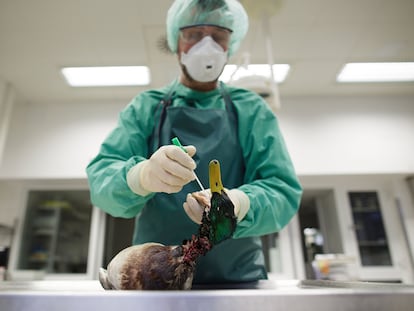How long does it take to catch coronavirus depending on the type of mask you’re wearing?
Surgical face coverings are not designed to contain infectious aerosols that accumulate in enclosed spaces. Experts recommend N95 masks, which are better fitted and have a higher filtration capacity
A recent study carried out by the American Conference of Governmental Industrial Hygienists (ACGIH), based on data provided by the US Centers for Disease Control and Prevention (CDC), estimates different timeframes for coronavirus contagion depending on the type of face mask a person is using. These range from 27 minutes for somebody wearing a cloth mask to up to 25 hours for someone wearing a perfectly adjusted N95 mask (the US equivalent of an FFP2 in Europe).
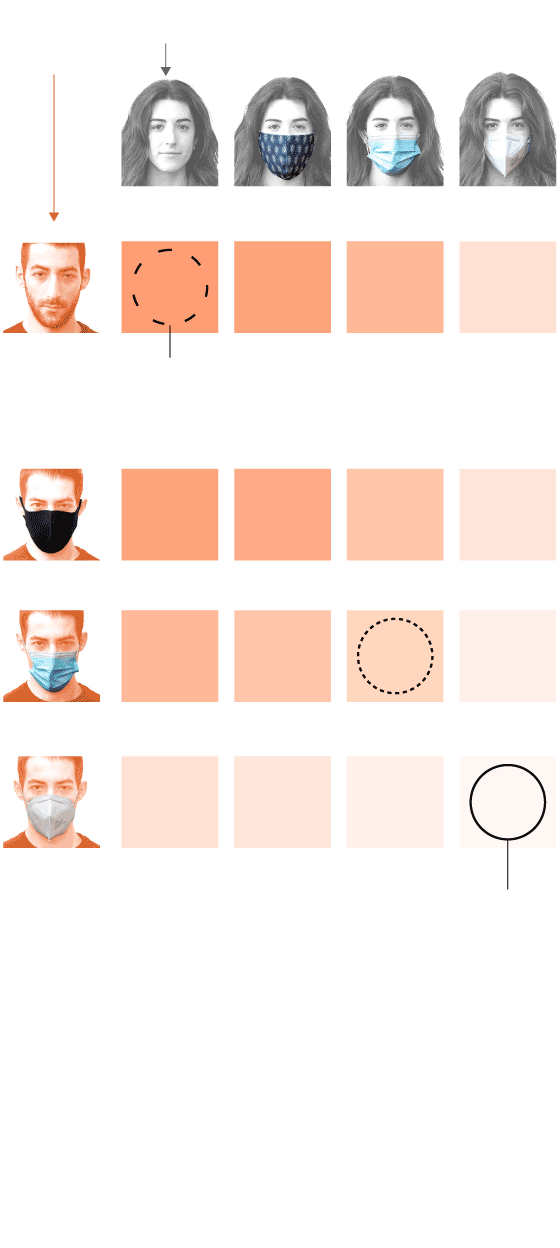
Healthy person
Infected
person
No mask
Cloth
Surgical
N95
15 MINS
20 MINS
30 MINS
2.5 HRS
No mask
In a closed space, without ventilation and no masks, an infected person can pass the virus to another in 15 minutes.
20 MINS
27 MINS
40 MINS
3.3 HRS
Cloth
30 MINS
40 MINS
60 MINS
5 HRS
Surgical
2.5 HRS
3.3 HRS
5 HRS
25 HRS
N95
A well-fitted N95 mask lets a maximum of 10% unfiltered air through. If two people are using them, infection is unlikely.
*All infection times in this infographic have been calculated in an enclosed, unventilated space with a distance of two meters between the two people.
Source: ACGIHRS and CDC.
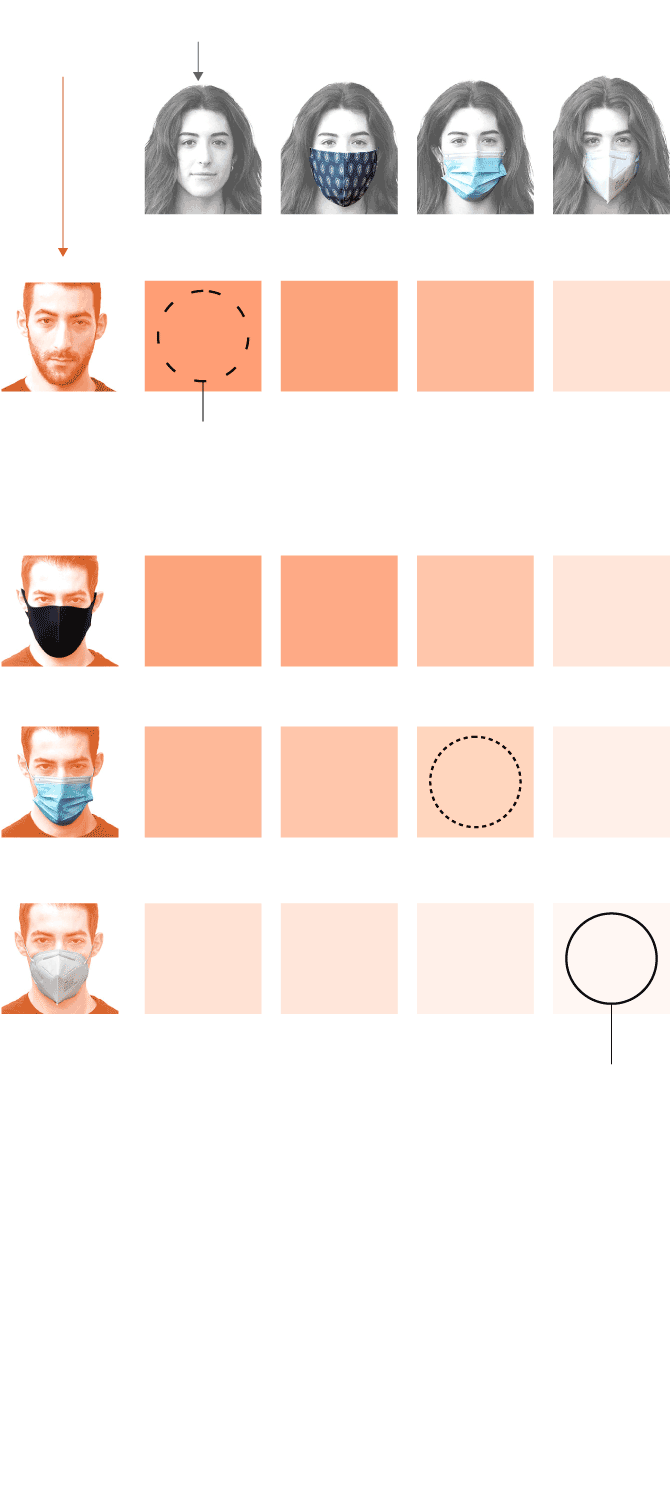
Healthy person
Infected
person
No mask
Cloth
Surgical
N95
15 MINS
20 MINS
30 MINS
2.5 HRS
No mask
In a closed space, without ventilation and no masks, an infected person can pass the virus to another in 15 minutes.
20 MINS
27 MINS
40 MINS
3.3 HRS
Cloth
30 MINS
40 MINS
60 MINS
5 HRS
Surgical
2.5 HRS
3.3 HRS
5 HRS
25 HRS
N95
A well-fitted N95 mask lets a maximum of 10% unfiltered air through. If two people are using them, infection is unlikely.
*All infection times in this infographic have been calculated in an enclosed, unventilated space with a distance of two meters between the two people.
Source: ACGIHRS and CDC.
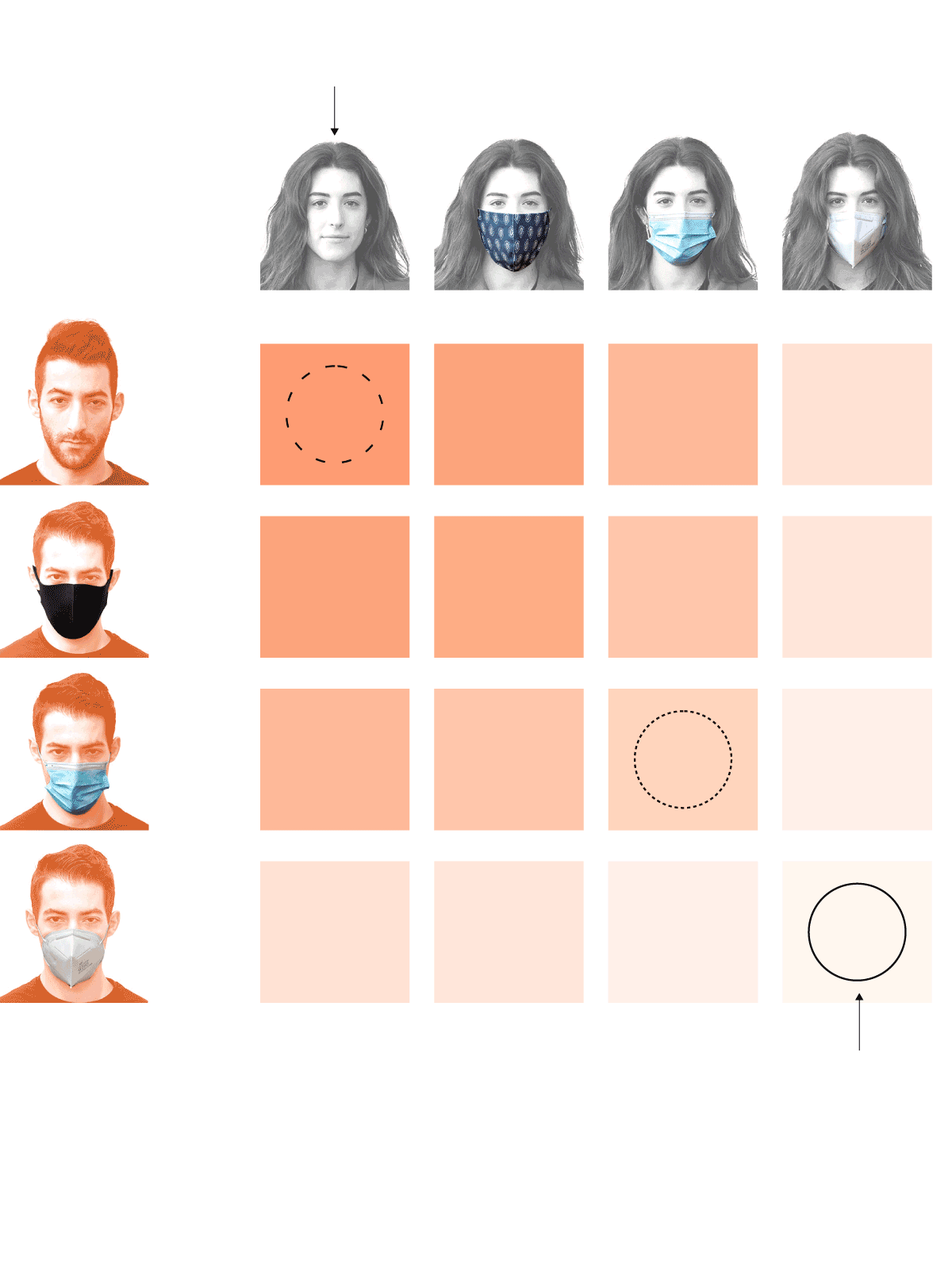
In a closed space, without ventilation and no masks, an infected person can pass the virus to another in 15 minutes.
Healthy
person
Infected
person
No mask
Cloth
Surgical
N95
No mask
15 MINS
20 MINS
30 MINS
2.5 HRS
Cloth
20 MINS
27 MINS
40 MINS
3.3 HRS
Surgical
30 MINS
40 MINS
60 MINS
5 HRS
N95
2.5 HRS
3.3 HRS
5 HRS
25 HRS
A well-fitted N95 mask lets a maximum of 10% unfiltered air through. If two people are using them, infection is unlikely.
*All infection times in this infographic have been calculated in an enclosed, unventilated space with a distance of two meters between the two people.
Source: ACGIHRS and CDC.
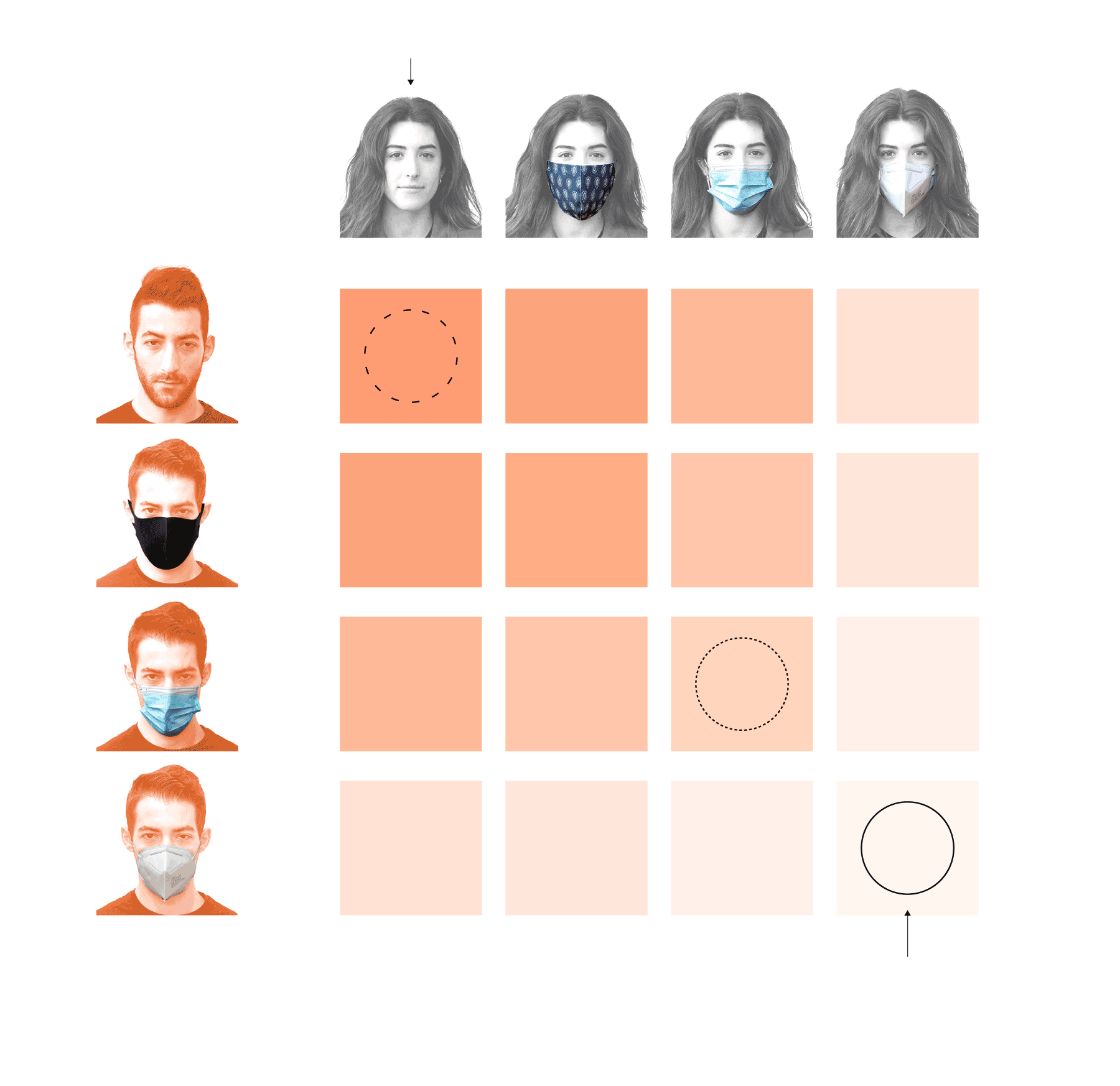
In a closed space, without ventilation and no masks, an infected person can pass the virus to another in 15 minutes.
Healthy
person
Infected
person
No mask
Cloth
Surgical
N95
No mask
15 MINS
20 MINS
30 MINS
2.5 HRS
Cloth
20 MINS
27 MINS
40 MINS
3.3 HRS
30 MINS
40 MINS
60 MINS
5 HRS
Surgical
N95
2.5 HRS
3.3 HRS
5 HRS
25 HRS
A well-fitted N95 mask lets a maximum of 10% unfiltered air through. If two people are using them, infection is unlikely.
*All infection times in this infographic have been calculated in an enclosed, unventilated space with a distance of two meters between the two people.
Source: ACGIHRS and CDC.
These masks were in short supply in the early days of the pandemic, but now that they are commonplace, scientists and health authorities have been stressing the importance of using this kind of effective protection against coronavirus, pointing out that masks made of cloth and surgical masks are not equipped with a facial seal and are loose-fitting, thereby allowing a large quantity of aerosols to escape.
In the United States, the Joe Biden administration announced in January it would distribute 400 million N95 face masks to people across the country free of charge as part of the president’s strategy to combat the spread of the more-contagious omicron variant of the coronavirus. Since December, anybody wishing to attend the theater or a concert or use public transport in Italy has been obliged to wear a face mask of this grade to be granted access. In Spain, sales of FFP2 and FFP3 masks rose by 642% between November 2021 and January 2022 according to medical material distributor Cofares, while some Spanish regions such as Andalusia and Catalonia have asked that the wearing of this type of mask be made obligatory on public transport and during visits to senior homes.
The lack of protection against Covid-19 afforded by surgical masks is due to their loose-fitting design. Masks of this type are used to contain splashes on both sides of the fabric. During a surgical procedure, for example, they prevent the patient from being contaminated by drops of saliva from the mouths of the surgeons when they are talking, while also protecting the medical personnel from blood and other fluids from the patient. Furthermore, the filters in these masks only trap particles of between three and seven microns in size. This means that bacteria and other large aerosols are retained by the mask, but other finer aerosols, such as those that transmit the coronavirus, are able to get through.

Aerosols
Surgical
mask
Their loose design allows for up to 50% of the air (and aerosols) that we breathe to enter and escape.
Surgical
mask
Aerosols
Droplets
and splatter
These are designed specifically to stop infectious droplets that we emit when we speak, cough and sneeze, but not to trap the air nor the possible infectious aerosols.
Surgical
mask
Filter
During their production and professional use, tests are not carried out on the fit, only on the filtering material.
Surgical
0.3
1
2
3
7
microns
N95
0.3
1
2
3
7
microns
*Micron: a thousandth of a millimeter
Most of the aerosols that we breathe are smaller than 3 microns. Surgical masks do not trap these, but well-fitted N95 masks do.

Aerosols
Surgical
mask
Their loose design allows for up to 50% of the air (and aerosols) that we breathe to enter and escape.
Surgical
mask
Aerosols
Droplets
and splatter
These are designed specifically to stop infectious droplets that we emit when we speak, cough and sneeze, but not to trap the air nor the possible infectious aerosols.
Surgical
mask
Filter
During their production and professional use, tests are not carried out on the fit, only on the filtering material.
Surgical
0.3
1
2
3
7
microns
N95
0.3
1
2
3
7
microns
*Micron: a thousandth of a millimeter
Most of the aerosols that we breathe are smaller than 3 microns. Surgical masks do not trap these, but well-fitted N95 masks do.

Surgical
mask
Aerosols
Aerosols
Surgical
mask
Droplets
and splatter
Their loose design allows for up to 50% of the air (and aerosols) that we breathe to enter and escape.
These are designed specifically to stop infectious droplets that we emit when we speak, cough and sneeze, but not to trap the air nor the possible infectious aerosols.
Surgical
mask
Filter
During their production and professional use, tests are not carried out on the fit, only on the filtering material.
Surgical
Most of the aerosols that we breathe are smaller than 3 microns. Surgical masks do not trap these, but well-fitted N95 masks do.
0.3
1
2
3
7
microns
N95
0.3
1
2
3
7
microns
*Micron: a thousandth of a millimeter
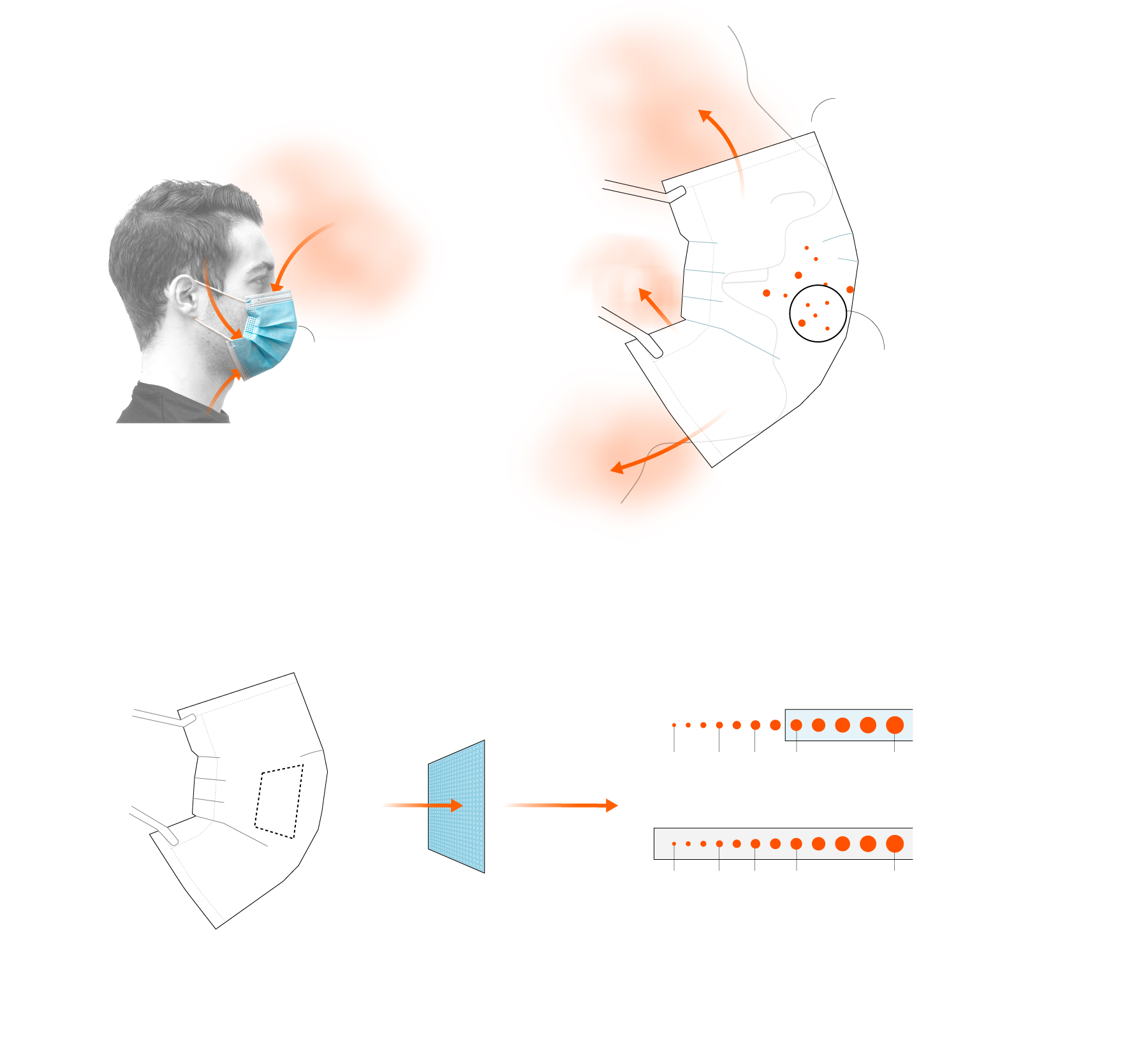
Aerosols
Surgical
mask
Aerosols
Surgical
mask
Droplets
and splatter
These are designed specifically to stop infectious droplets that we emit when we speak, cough and sneeze, but not to trap the air nor the possible infectious aerosols.
Their loose design allows for up to 50% of the air (and aerosols) that we breathe to enter and escape.
Surgical
mask
Surgical
Filter
0.3
1
2
3
7
microns
N95
*Micron: a thousandth
of a millimeter
0.3
1
2
3
7
microns
During their production and professional use, tests are not carried out on the fit, only on the filtering material.
Most of the aerosols that we breathe are smaller than 3 microns. Surgical masks do not trap these, but well-fitted N95 masks do.
The N95, which is considered a high-protection mask and used in the prevention of respiratory diseases, is designed to retain fine aerosols. To achieve this, such masks are better adjusted to the contours of the face and have a filter capable of trapping up to 95% of particles measuring three microns (94% in the case of the FFP2). “For an FFP2 mask to meet all the regulations you have to perform 15 or 20 different tests. In the case of surgical masks, only four are carried out: filtration of bacteria, respirability, whether or not they contaminated and if they are splash-resistant,” explains José María Lagarón, a researcher at the Spanish National Research Council (CSIC).
The fit of a mask and its seal are more important than the filtration efficacy of its component materials when it comes to reducing leakage on the inside of the fabric. Ensuring an optimal fit is also important with these masks, as a gap between mask and face equivalent to as little as 2% of the mask’s surface would allow up to 50% of air to pass through unfiltered.

Recommendations for a good fit
Facial seal
Beards can
impede a
good fit
N95
The best filtration and facial seal are offered by an N95 mask (N95 in Europe) that is well fitted around the head and the neck.
Knot
Surgical
mask
A knot tied in the bands of the mask improves the fit and reduces the entry and exit of aerosols.
Silicone
fixer
Mask
fitter
The best recommendation to ensure a good facial seal of a surgical mask is to use a silicone mask fitter.

Recommendations for a good fit
Facial seal
Beards can
impede a
good fit
N95
The best filtration and facial seal are offered by an N95 mask (N95 in Europe) that is well fitted around the head and the neck.
Knot
Surgical
mask
A knot tied in the bands of the mask improves the fit and reduces the entry and exit of aerosols.
Silicone
fixer
Mask
fitter
The best recommendation to ensure a good facial seal of a surgical mask is to use a silicone mask fitter.
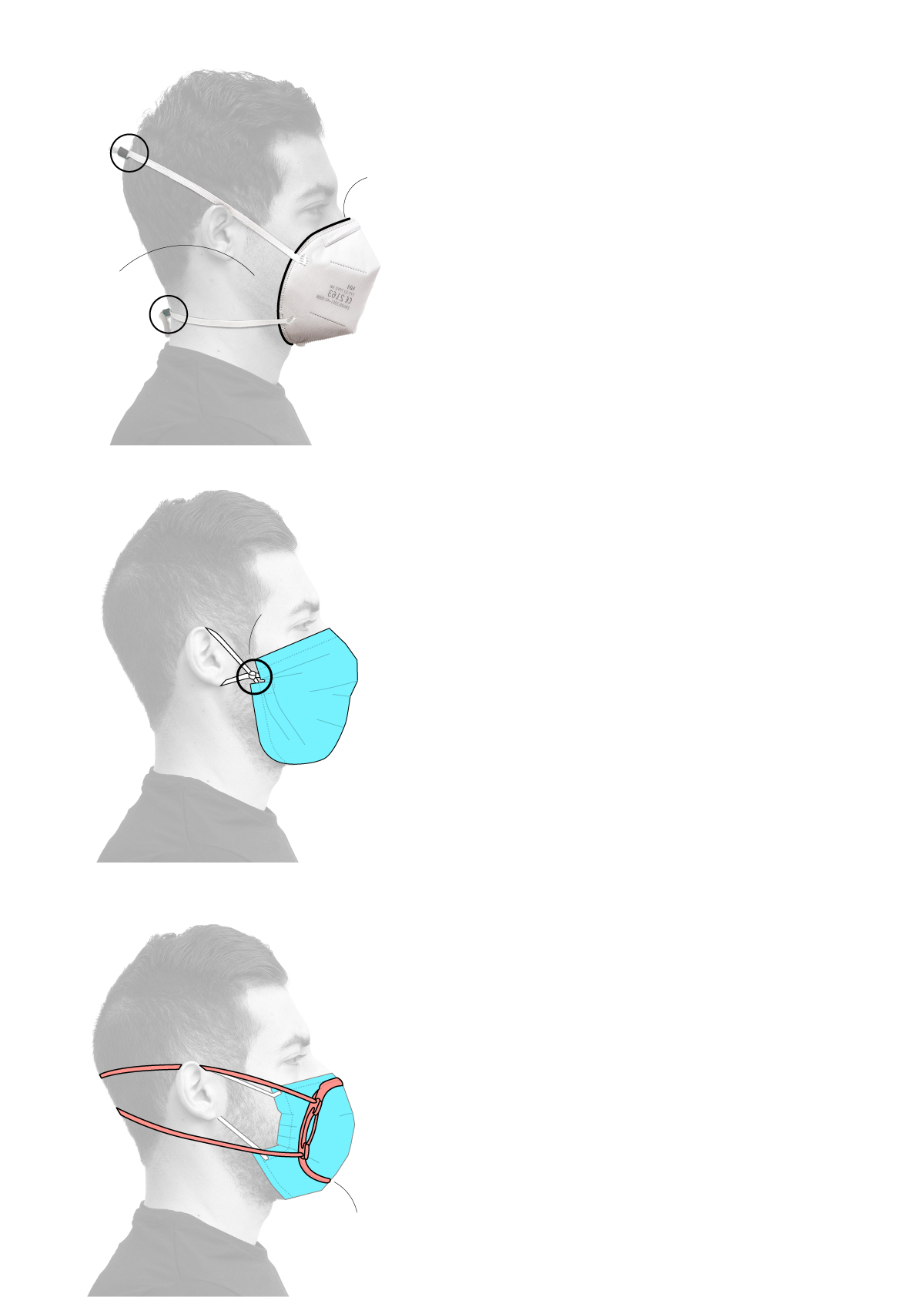
Recommendations for a good fit
N95
Facial seal
The best filtration and facial seal are offered by an N95 mask (N95 in Europe) that is well fitted around the head and the neck.
Beards can
impede a
good fit
Surgical
mask
Knot
A knot tied in the bands of the mask improves the fit and reduces the entry and exit of aerosols.
Surgical
mask
The best recommendation to ensure a good facial seal of a surgical mask is to use a silicone mask fitter.
Mask
fitter
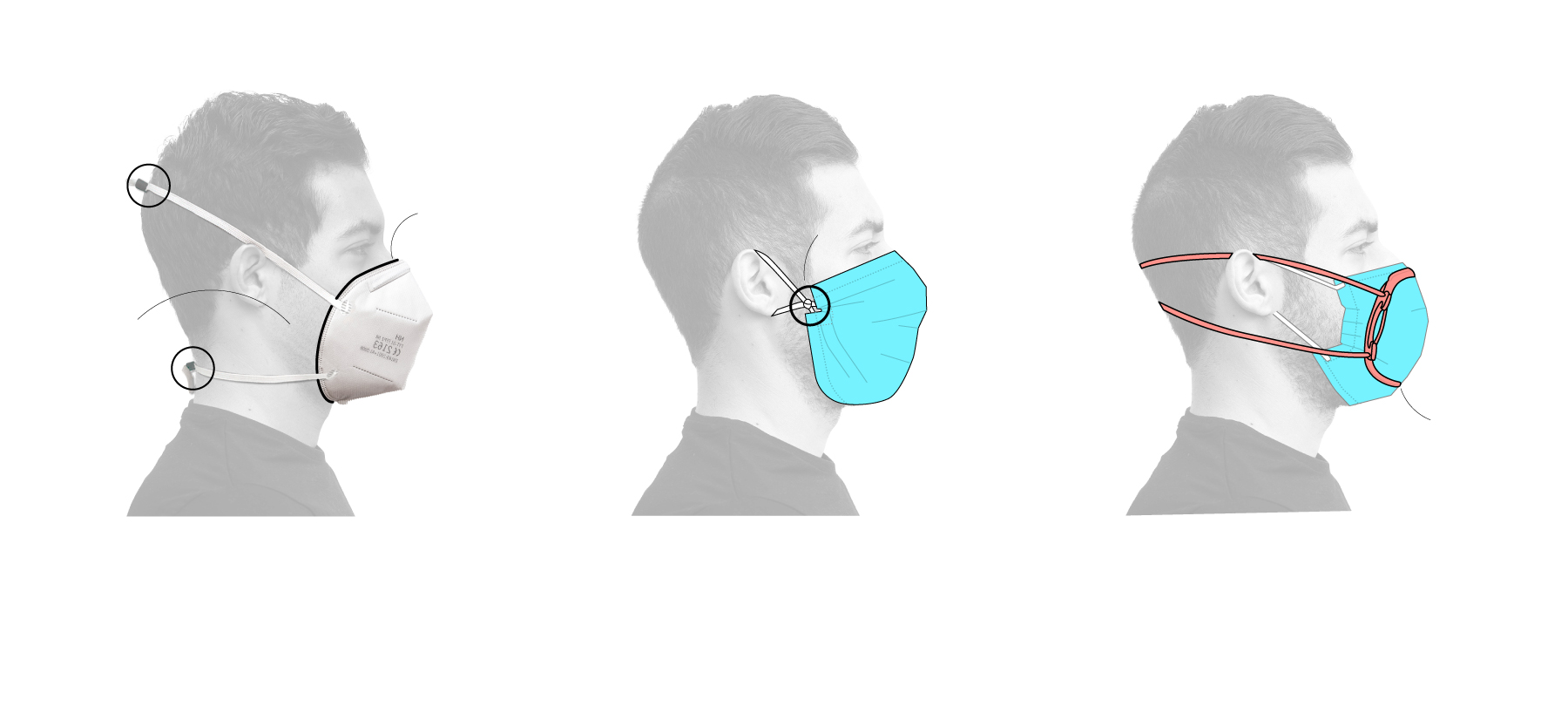
Recommendations for a good fit
N95
Surgical
mask
Surgical
mask
Facial seal
Knot
Beards can
impede a
good fit
Mask
fitter
A knot tied in the bands of the mask improves the fit and reduces the entry and exit of aerosols.
The best recommendation to ensure a good facial seal of a surgical mask is to use a silicone mask fitter.
The best filtration and facial seal are offered by an N95 mask (N95 in Europe) that is well fitted around the head and the neck.
Tests to measure the concentration of aerosols on the interior and exterior of masks establish the minimum fit factor required to provide effective protection at 100. “A good FFP2 mask has a fit factor of over 200; a surgical mask can be as low as two,” explains Santos Huertas, director of research and innovation at Spanish occupational accidents and diseases insurer Asepeyo.
The type of fastening a mask has, the researcher explains, is key to ensuring an optimal fit. Masks that fit around the ears have much lower fit factors than those that are attached around the nape of the neck and the crown of the head. However, the fit of masks that use ear supports can be improved by a cardboard or plastic hook that links both straps behind the head. Whichever type of fastening is employed, it is essential to ensure that the nose piece is correctly shaped to the wearer’s requirement and that the mask fits the overall shape of the user’s face.
N95 masks are more durable than surgical masks, which lose their efficacy after around four hours of use. A disposable mask has a useful life span of around eight hours, while reusable models can last for 30 hours. Between uses, it is important to ensure that the mask is allowed to dry out, while also checking that it is in good condition, has not been damaged in any way and that its fastenings retain their elasticity.

40
hours
N95
The maximum usage time for a reusable N95 mask is up to 40 hours, but according to the exposure to the virus, experts consulted say that they can last up to 20 days.
Low exposure to the virus
Ventilated spaces and
with few people.
20 days
10 days
5 days
Use:
8 hours
a day
4 hours
a day
2 hours
a day
* Provided that the mask remains dry
and is properly fitted.
High exposure to the virus
Hospitals and areas with high amounts
of people.
Viral inactivation
N95
N95
N95
N95
Day 1
Day 2
Day 3
Day 4
Tests carried out with high levels of virus showed that it can remain active up to 72 hours in an N95. Four N95 masks alternated every 72 hours could last up to 20 days.

40
hours
N95
The maximum usage time for a reusable N95 mask is up to 40 hours, but according to the exposure to the virus, experts consulted say that they can last up to 20 days.
Low exposure to the virus
Ventilated spaces and
with few people.
20 days
10 days
5 days
Use:
8 hours
a day
4 hours
a day
2 hours
a day
* Provided that the mask remains dry
and is properly fitted.
High exposure to the virus
Hospitals and areas with high amounts
of people.
Viral inactivation
N95
N95
N95
N95
Day 1
Day 2
Day 3
Day 4
Tests carried out with high levels of virus showed that it can remain active up to 72 hours in an N95. Four N95 masks alternated every 72 hours could last up to 20 days.
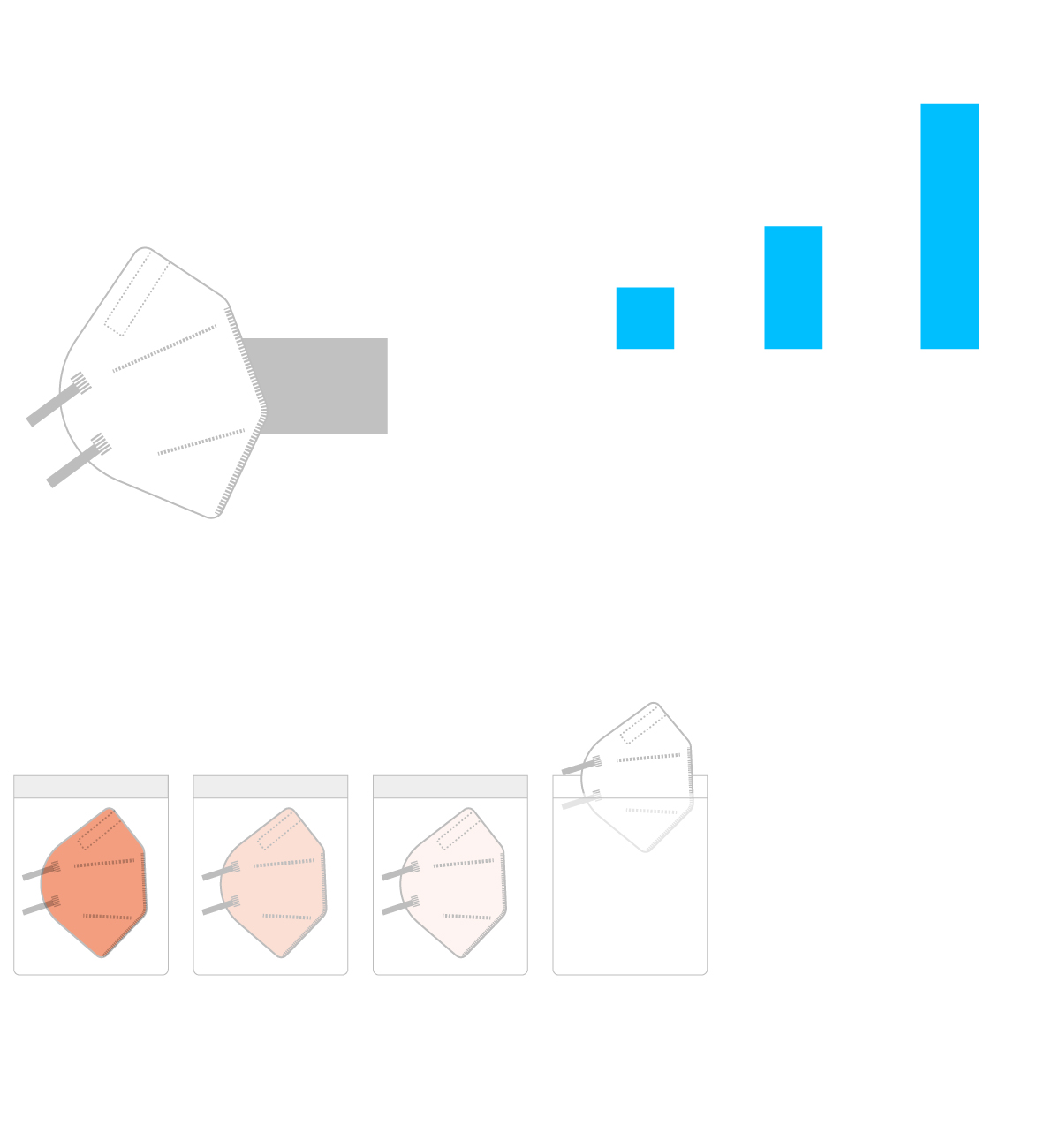
The maximum usage time for a reusable N95 mask is up to 40 hours, but according to the exposure to the virus, experts consulted say that they can last up to 20 days.
Low exposure to the virus
Ventilated spaces and
with few people.
20 days
10 days
5 days
40
hours
Use:
8 hours
a day
4 hours
a day
2 hours
a day
N95
* Provided that the mask remains dry
and is properly fitted.
High exposure to the virus
Hospitals and areas with high amounts of people.
Viral inactivation
N95
Four N95 masks alternated every 72 hours could last up to 20 days.
N95
N95
N95
Day 1
Day 2
Day 3
Day 4
Tests carried out with high levels of virus showed that it can remain active up to 72 hours in an N95.

The maximum usage time for a reusable N95 mask is up to 40 hours, but according to the exposure to the virus, experts consulted say that they can last up to 20 days.
40
hours
N95
Low exposure to the virus
Ventilated spaces and
with few people.
High exposure to the virus
Hospitals and areas with high amounts of people.
20 days
Viral inactivation
N95
Four N95 masks alternated every 72 hours could last up to 20 days.
10 days
N95
N95
N95
5 days
Use:
Day 1
Day 2
Day 3
Day 4
8 hours
a day
4 hours
a day
2 hours
a day
Tests carried out with high levels of virus showed that it can remain active up to 72 hours in an N95.
* Provided that the mask remains dry
and is properly fitted.
Methodology: Contagion times based on the type of mask used come from a study carried out by ACGIH, using as a reference point the 15 minutes that it takes two people not wearing masks to become infected with the coronavirus, then estimating the remainder of the timeframes based on the performance of the various different types of masks.
Sources: José María Lagarón (CSIC), José Luis Jiménez (University of Colorado), Elena Plaza (nurse and teacher), Santos Huertas (Asepeyo), Pablo Medina (risk-prevention technician), US Centers for Disease Control and Prevention (CDC), European Centre for Disease Prevention and Control (ECDC), Spanish Health Ministry.
